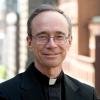The regulations for balloting are very detailed to eliminate any suspicion of electoral fraud—no hanging chads here. According to the 1996 constitution Universi Dominici Gregis (“Of the Lord’s Whole Flock”) of John Paul II, three “scrutineers” (vote counters) are chosen by lot from the electors, with the least senior cardinal deacon drawing the names. He draws three additional names of cardinals (called infirmarii) who will collect the ballots of any cardinals in the conclave who are too sick to come to the Sistine Chapel. A final three names are drawn by lot to act as revisers, who review the work done by the scrutineers. Each morning and afternoon, new scrutineers, infirmarii and revisers are chosen by lot.
The electors use rectangular cards as ballots with “Eligo in summum pontificem” (“I elect as supreme pontiff”) printed at the top. When folded down the middle the ballot is only one inch wide. Each cardinal, in secret, prints or writes the name of his choice on the ballot in a way that disguises his handwriting. One at a time, in order of precedence, the cardinals approach the altar with their folded ballot held up so that it can be seen. After kneeling in prayer for a short time, the cardinal rises and swears, “I call as my witness Christ the Lord who will be my judge, that my vote is given to the one who before God I think should be elected.” He then places the ballot in a silver and gilded bronze urn shaped like a wok with lid. There is a second smaller urn for ballots cast in the Domus Sanctae Marthae by cardinals too ill to go to the Sistine Chapel.
The first scrutineer shakes the egg-shaped urn to mix the ballots. The last scrutineer counts the ballots before they are unfolded. If the number of ballots does not correspond to the number of electors, the ballots are burned without being counted and another vote is immediately taken. If the number of ballots does match the number of electors, the scrutineers, who are sitting at a table in front of the altar, begin counting the votes.
The first scrutineer unfolds the ballot, notes the name on a piece of paper and passes the ballot to the second scrutineer. He notes the name and passes the ballot to the third scrutineer, who reads it aloud for all the cardinals to hear. If there are two names on a single ballot, the ballot is not counted. The last scrutineer pierces each ballot with a threaded needle through the word “Eligo” and places it on the thread. After all the ballots have been read, the ends of the thread are tied together and the ballots thus joined are placed in a third urn. The scrutineers then add up the totals for each candidate. Finally, the three revisers check both the ballots and the notes of the scrutineers to make sure that they performed their task faithfully and exactly.
To be elected, two thirds of the votes are required, calculated on the basis of the total number of electors present. Should it be impossible to divide the number of cardinals present into three equal parts, for the validity of the election one additional vote is required. Thus if all the current 120 cardinal electors are present, 80 votes would be required to elect a new pope. With 115 electors in this conclave, 77 votes will be required.
The ballots and notes (including those made by any cardinal) are then burned unless another vote is to take place immediately. The ballots are burned by the scrutineers with the assistance of the secretary of the conclave and the master of ceremonies, who adds special chemicals to make the smoke white or black. Since 1903, white smoke has signaled the election of a pope; black smoke signals an inconclusive vote. Because the smoke came out gray so often, the ringing of St. Peter's largest bell is rung as an additional signal of a successful ballot.
The only written record of the voting permitted is a document prepared by the camerlengo and approved by the three cardinal assistants, which is prepared at the end of the election and gives the results of each session. This document is given to the new pope and then placed in the archives in a sealed envelope that may be opened by no one unless the pope gives permission.
Follow Reese on Twitter: @ThomasReeseSJ. His email is treesesj@NCRonline.org.




